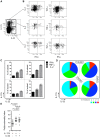Evaluating cellular polyfunctionality with a novel polyfunctionality index
- PMID: 22860124
- PMCID: PMC3408490
- DOI: 10.1371/journal.pone.0042403
Evaluating cellular polyfunctionality with a novel polyfunctionality index
Abstract
Functional evaluation of naturally occurring or vaccination-induced T cell responses in mice, men and monkeys has in recent years advanced from single-parameter (e.g. IFN-γ-secretion) to much more complex multidimensional measurements. Co-secretion of multiple functional molecules (such as cytokines and chemokines) at the single-cell level is now measurable due primarily to major advances in multiparametric flow cytometry. The very extensive and complex datasets generated by this technology raise the demand for proper analytical tools that enable the analysis of combinatorial functional properties of T cells, hence polyfunctionality. Presently, multidimensional functional measures are analysed either by evaluating all combinations of parameters individually or by summing frequencies of combinations that include the same number of simultaneous functions. Often these evaluations are visualized as pie charts. Whereas pie charts effectively represent and compare average polyfunctionality profiles of particular T cell subsets or patient groups, they do not document the degree or variation of polyfunctionality within a group nor does it allow more sophisticated statistical analysis. Here we propose a novel polyfunctionality index that numerically evaluates the degree and variation of polyfuntionality, and enable comparative and correlative parametric and non-parametric statistical tests. Moreover, it allows the usage of more advanced statistical approaches, such as cluster analysis. We believe that the polyfunctionality index will render polyfunctionality an appropriate end-point measure in future studies of T cell responsiveness.
Conflict of interest statement
Figures




References
-
- Sauce D, Almeida JR, Larsen M, Haro L, Autran B, et al. (2007) PD-1 expression on human CD8 T cells depends on both state of differentiation and activation status. AIDS 21: 2005–2013. - PubMed
-
- Papagno L, Alter G, Assoumou L, Murphy RL, Garcia F, et al. (2011) Comprehensive analysis of virus-specific T-cells provides clues for the failure of therapeutic immunization with ALVAC-HIV vaccine. AIDS 25: 27–36. - PubMed
-
- Betts MR, Price DA, Brenchley JM, Lore K, Guenaga FJ, et al. (2004) The functional profile of primary human antiviral CD8+ T cell effector activity is dictated by cognate peptide concentration. J Immunol 172: 6407–6417. - PubMed
Publication types
MeSH terms
LinkOut - more resources
Full Text Sources
Other Literature Sources

